Sony EE34: Sony Makes Budget AMD Laptops?
by Dustin Sklavos on February 22, 2011 4:43 PM ESTNot Fast, But Fast Enough
Historically we've been pretty underwhelmed with AMD's mobile offerings, barring maybe the Turion II Neo and now Brazos. These aren't bad chips, but if AMD's been struggling to play catch-up on the desktop they've been left miles behind in notebooks where power and heat become ever more important.
With that said, though, the 25W, 2.2GHz Athlon II P340 dual-core processor isn't a particularly bad chip either. Inheriting the K10.5 architecture from its desktop siblings, it at least offers a good bump over older K8-based chips and is capable of handling most of the tasks you're liable to throw at it.
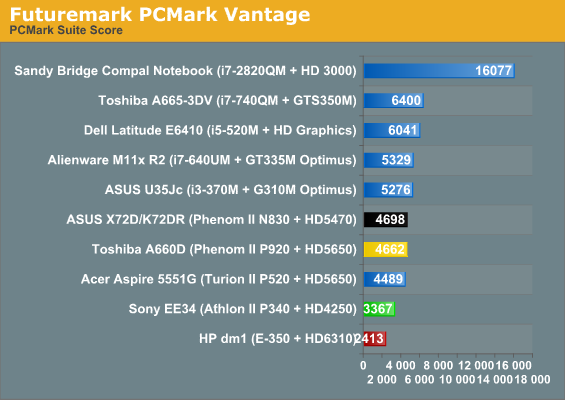
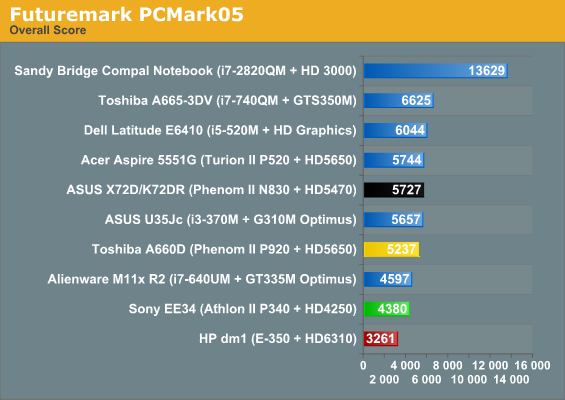
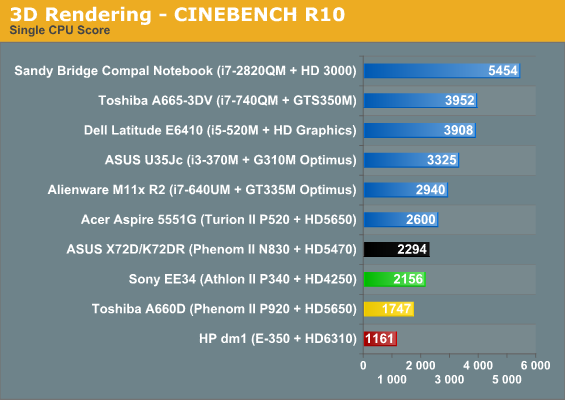
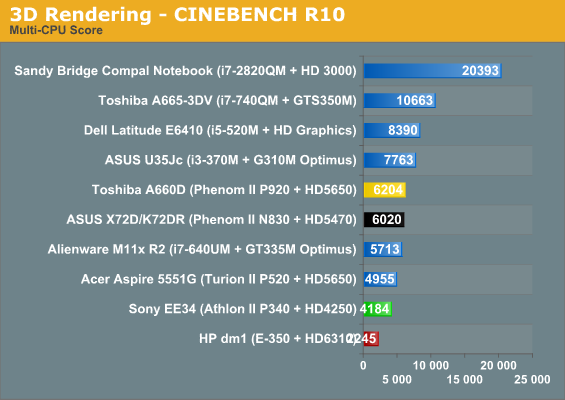
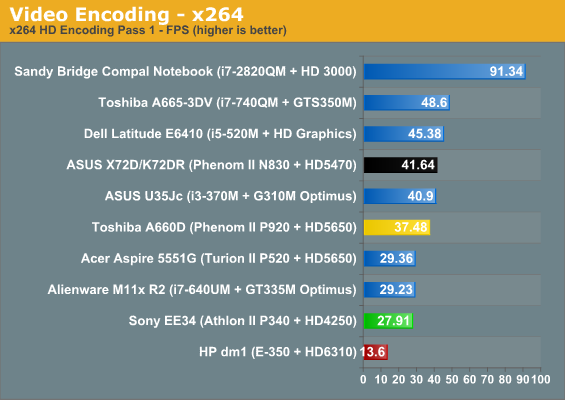
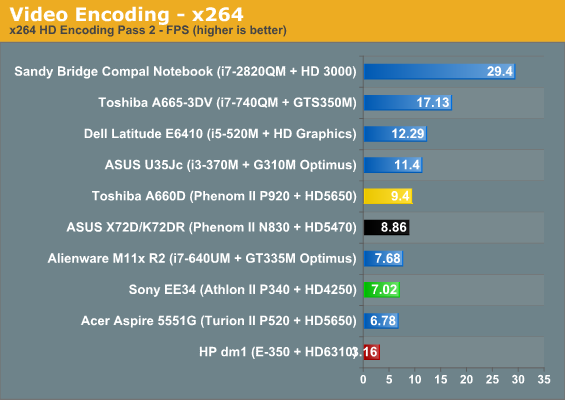
Before we get too far in analyzing these results, it's important to note that our usual x264 benchmark refused to run on the EE34 and would always crash at exactly the same point. This occurred whether on the factory install or on a clean installation of Windows 7, and it's the only time we've ever seen this happen. The EE34 completed all our other tests perfectly fine and was nice and stable in regular use, but it bears mentioning that for the x264 results we did have to simulate the processor using a desktop Athlon II X4 with two cores disabled and the clocks adjusted. I'm confident that these scores are within the ballpark for what you could expect from the Athlon II P340, but they bear mentioning nonetheless.
Comparing against the other AMD processors in the lineup, the P920 is a quad-core chip running at 1.6GHz while the N830 is a tri-core chip running at 2.1GHz. So with that in mind, the tri-core running at 100MHz slower than the P340 in the EE34 seems like it's probably the best compromise, but the P340 doesn't put in an awful showing either. All of the AMD chips are more or less dwarfed by their Intel rivals, but it's not a complete bloodbath. For reference we've included the E-350's scores so you can see what bumping up to even a slower full-sized AMD notebook can get you.
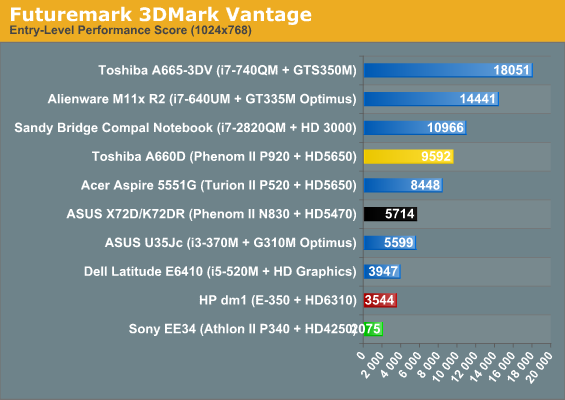

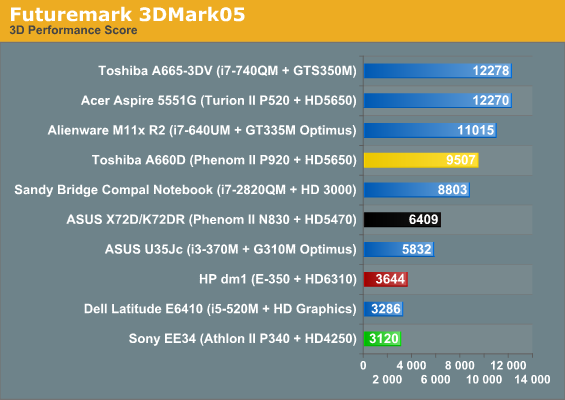
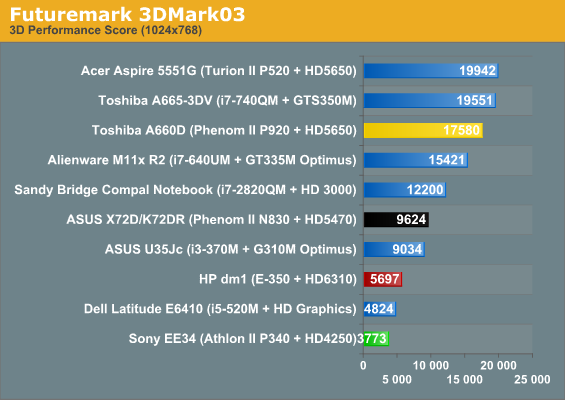
Unfortunately the 3DMark tests bear out just how poorly AMD's 40-shader IGP has aged. The E-350 beats it at every turn and even the utterly anemic GeForce 310M is a substantial improvement. While Llano's CPU performance doesn't promise to be a substantial improvement over what we've seen here (the cores are basically K10.5), the integrated graphics should at least be a big enough boost to make it a very compelling mobile part. Hopefully between Brazos, Llano, and Sandy Bridge, the era of poor integrated graphics can finally come to a close.










52 Comments
View All Comments
silverblue - Tuesday, February 22, 2011 - link
I really doubt that AMD will release a faster IGP than the 4250 on this type of platform, or even one with more shaders, simply because it detracts from the Fusion initiative. Had they not gone the Fusion route, we probably would be seeing IGPs on the same level as, say, the 3850, by now (one can hope, though Llano should easily meet that).At the very least, it'd have been nice to see a 40nm version of the 4250 and not the 55nm versions we've been seeing for a couple of years, especially since Intel is producing their HD Graphics on a lower node.
nitrousoxide - Tuesday, February 22, 2011 - link
Llano IGP has 320 shaders, and should run at really high frequency. So it's reasonable to expect Mobility 5650 (or GT425M) level performance.mino - Tuesday, February 22, 2011 - link
320 ? Umm. More like 400(+) ...duploxxx - Wednesday, February 23, 2011 - link
ain't that funny arguing about shader count while you actually don't know for sure??? :)Liano will have 160-240-320-400 shaders in notebook depending on model, now you know.
And now it doesn't run really high frequency but indeed the highend will be around Mob 5650 perf and will run circles around anything integrated Intel can offer.
StevoLincolnite - Tuesday, February 22, 2011 - link
That might be true for lower resolutions... Just remember it still has to use system memory which is slower and of higher latency when compared to a discreet cards own memory subsystem (Plus system RAM's bandwidth is shared between all components.)Only so large and complex you can make an IGP before it is essentially pointless, on the bright side compute tasks should be decent.
silverblue - Wednesday, February 23, 2011 - link
It'll handle higher loads than Brazos, though Brazos wasn't really positioned as a gaming option.A triple channel memory interface would be immensely helpful but unfortunately incredibly unlikely to happen. The real value of Llano should be proven by throwing faster RAM at it; those RAM tests which yielded very little improvement should no longer apply.
I can't see Llano achieving 5650 performance in bandwidth-limited situations, however one might argue that anti-aliasing and anisotropic filtering aren't options suited to such platforms so if you leave those out, it should perform quite well.
nitrousoxide - Wednesday, February 23, 2011 - link
1366x768 gaming isn't that bandwidth limited. My laptop runs at 1600x900 with 128bit D3 running at 800MHz. So that's only 25.6GB/s available bandwidth but still managed to run Black Ops/Need for Speed Shift at highest settings and rarely dropped below 30fps. While Llano won't be that fast to handle HD gaming, at 1366x768 (which is the standard resolution for most 14 inch laptops) it should really provide decent gaming experience.drew_afx - Tuesday, February 22, 2011 - link
Thanks for the thorough reviews on this siteit's really informative and accurate
but since a lot of people like myself visit here to
decide on which tech product to choose from,
is it possible to include a comparison chart of carrying weight?
I can see the specs on the first page, but
those i5's and i7 laptops w/ more than double the
charge capacity of sony's battery should be packing at least
a solid pound more. Efficiency wise, it would be better to compare
laptops by weight too, since power vs weight is always good comparison
in cars(efficiency of engine). As the review noted, this range of laptops is
suitable for college students who need multitasking, but don't need
gaming or video encoding power w/ more weight.
Another good measure of laptop comparison can be the
practical part of design. Does the vents on the bottom get blocked
when put on lap?(the pictures w/temps were very helpful) Is it single or dual heatsink/fan?
Is it easy to disassemble and clean vents later? Can it be
held with one hand comfortably, both when opened and closed without flexing?
any sign of lcd distortion when pressed on the back cover? hinge quality?
keyboard & mouse clicking noise level? I think one of the reasons for
apple's success in educational notebooks is due to meeting these practical design
criteria.
Malih - Wednesday, February 23, 2011 - link
interesting, it's good to include these kindof daily usage annoyances test, cause that's what we're facing everyday, it will complete the review as buyer's guideScreammit - Wednesday, February 23, 2011 - link
Positioning of the vents is one of the first things I look at when I make a laptop purchase. I greatly prefer that the main intake or outtake is not on the bottom.